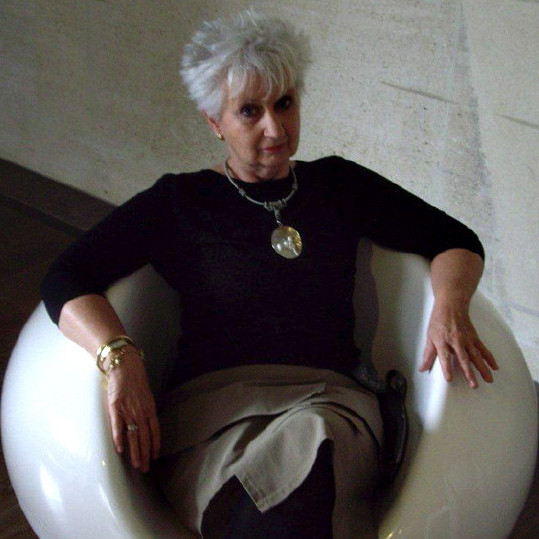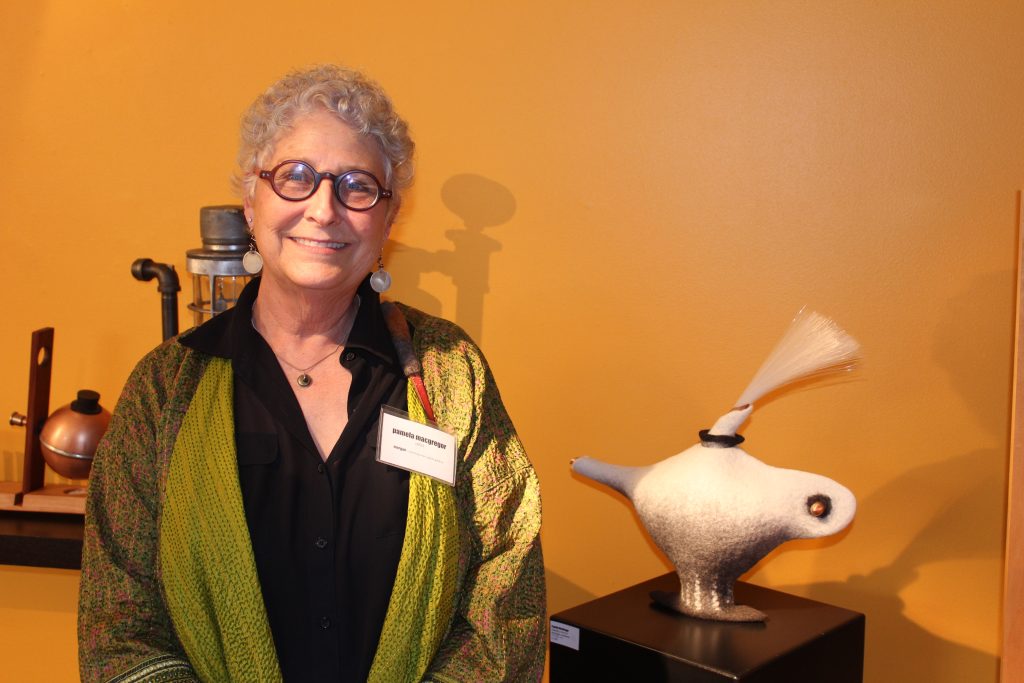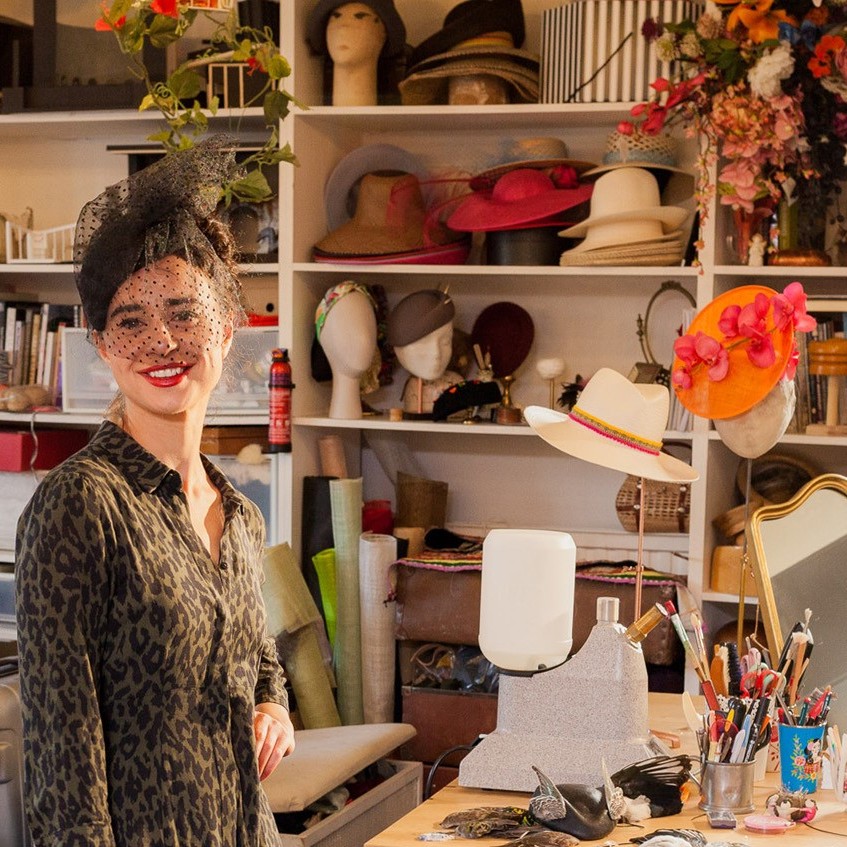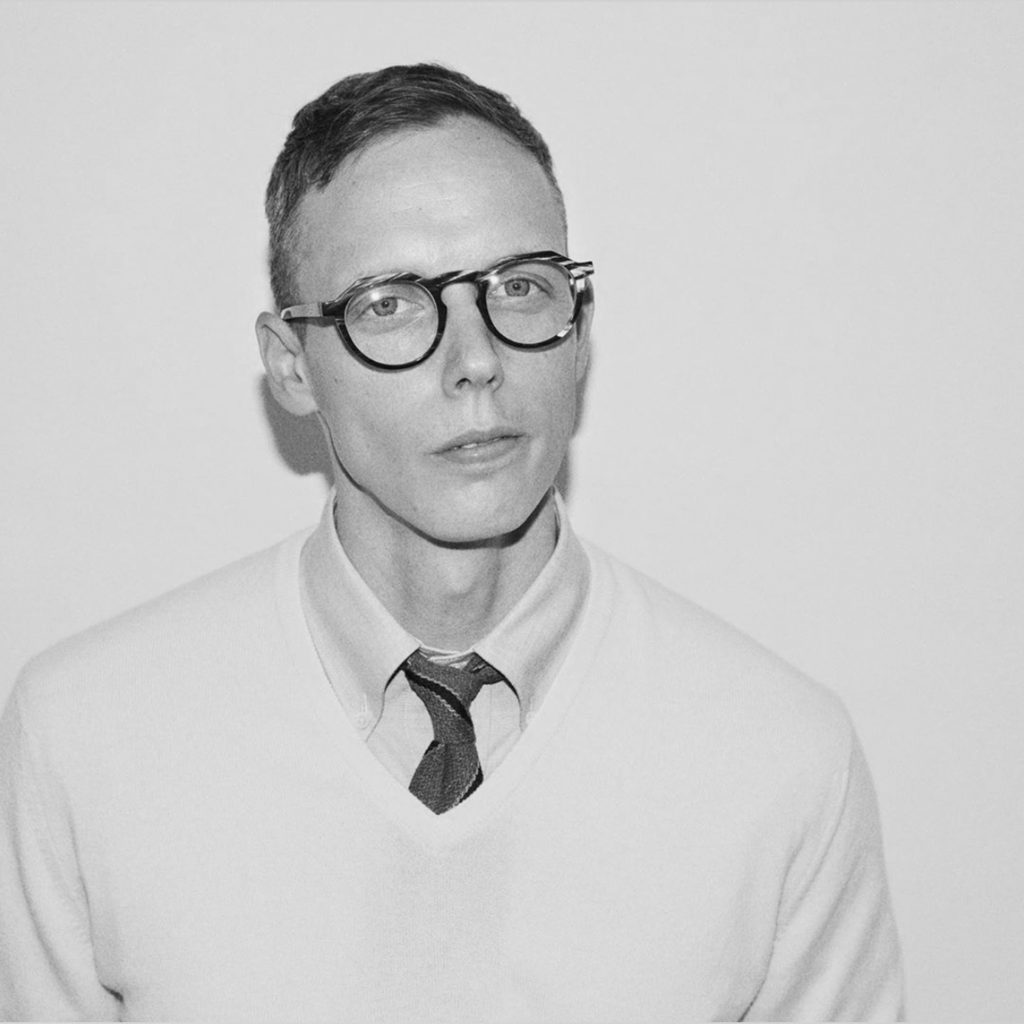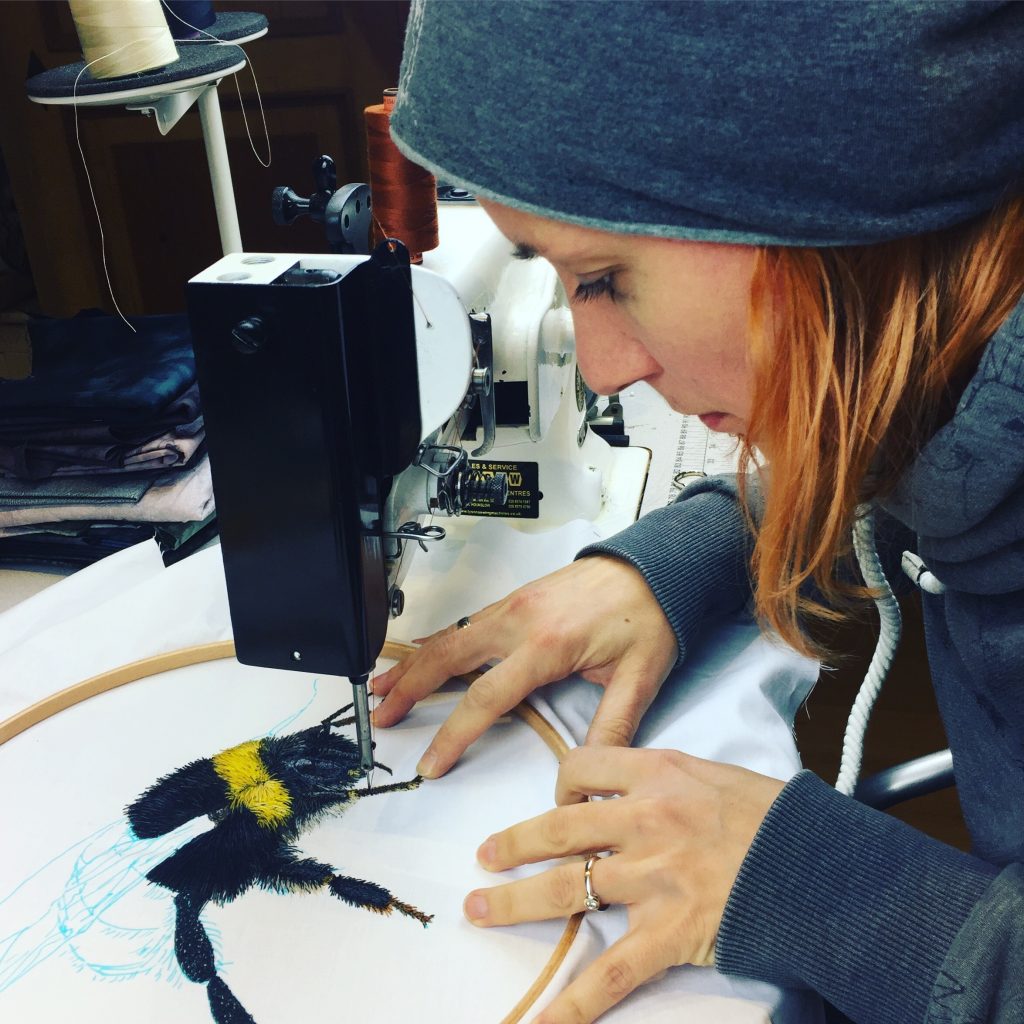Pamela MacGregor Textile Artist
Explain how you were introduced to felt and the possibilities it presents to you artistically?
I was an art teacher for 28 years in a public school. I took classes or workshops to keep my teaching certificate current. My first felting workshop was in 2004 and I was immediately in love with it. Felt is the only medium I have found that allows me to make clothing, shoes, jewelry, sculpture and much more. The possibilities with felt are endless with lots of challenges.
Much of your current work is 3D discuss this aspect of felting?
I majored in jewelry design and ceramics at university so it was natural for me to lean towards the 3D in felting. I find the engineering possibiities while working with a flat pattern and developing that flat pattern into a 3-D sculptural form very exciting. Each new work is another challenge to explore and figure out. I find it energizes my creative spirit.
Can you share your studio with us and discuss?
I converted a part of my horse barn into a very workable studio. It is small but full of all my collections such as bird nests, bones, dried pods, feathers and other wonderful found objects. My interest in nature is obvious as soon as you enter.
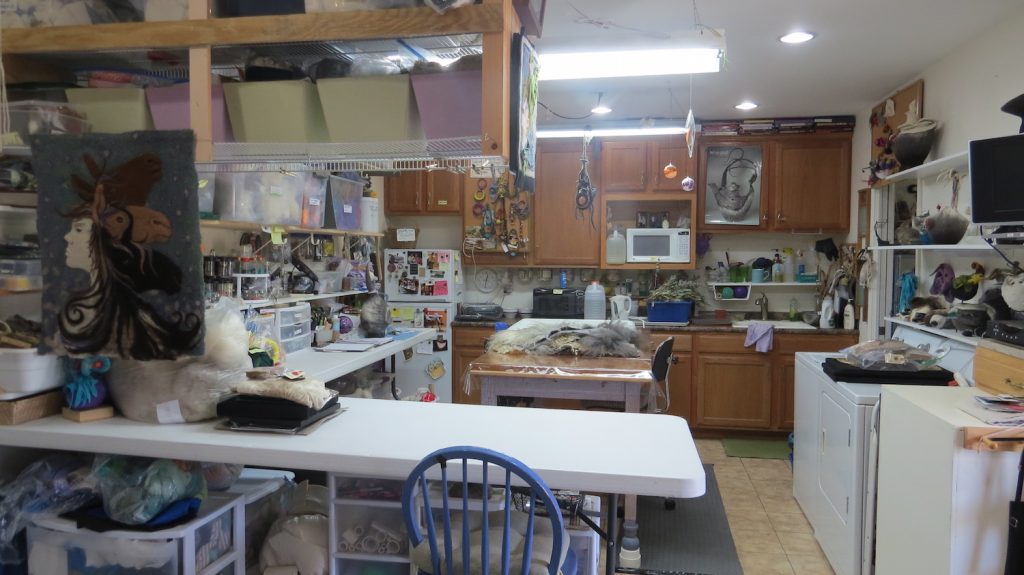
The studio has a washer, dryer, 2 microwaves, one for dying and one for food and a 3/4 size refrigerator. It has all the amenities of a small studio apartment with a full bathroom. Quite often I have students stay in the studio while taking a private workshop with me.
The sliding glass door opens out to a covered porch and over looks our pond and wooded area.
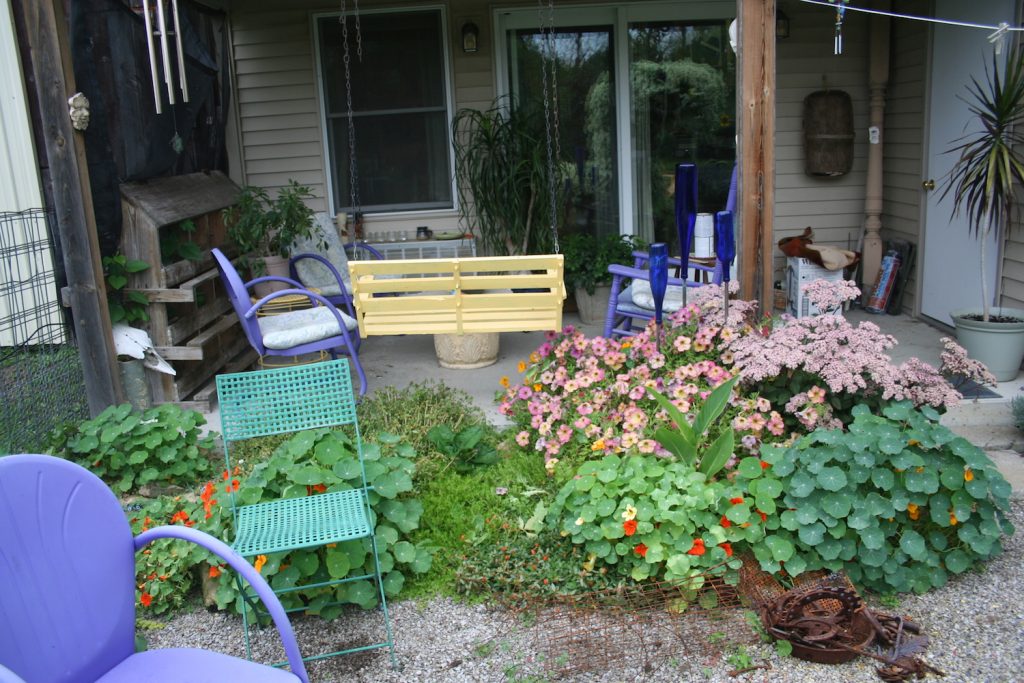
Behind the Studio in Summer
Lighting
I have large windows with inset ceiling lights as well as hanging fluorescent lights.
Storage
Storage is always a problem in a small space. I try to keep everything at my fingertips using floor to ceiling free hanging shelves. The materials I use the most are at eye level. I keep my wool in clear plastic tubs. I find that if I can see it I will use it. If the wool is out of site it is often out of mind. For added storage I use old chest type freezers with their plugs clipped off. These freezers are in the aisle of barn not in the studio. They are a great way for me to store the extra, seldom used wool and raw fleeces and they totally protect the wool from bugs, moisture while giving me added counter space if needed. This system works like a dream.
Two essentials that make you studio so great
My studio is loaded with all my special “things” that just make me happy.”
It is a bright, quiet place and has a great view of our pond, the barn swallows, the woods and lovely sunsets. I often look out and see my old horse and pot bellied pig grazing contentedly as a dear walks delicately along the edge of the woods. It encourages me to breath, relax and create.
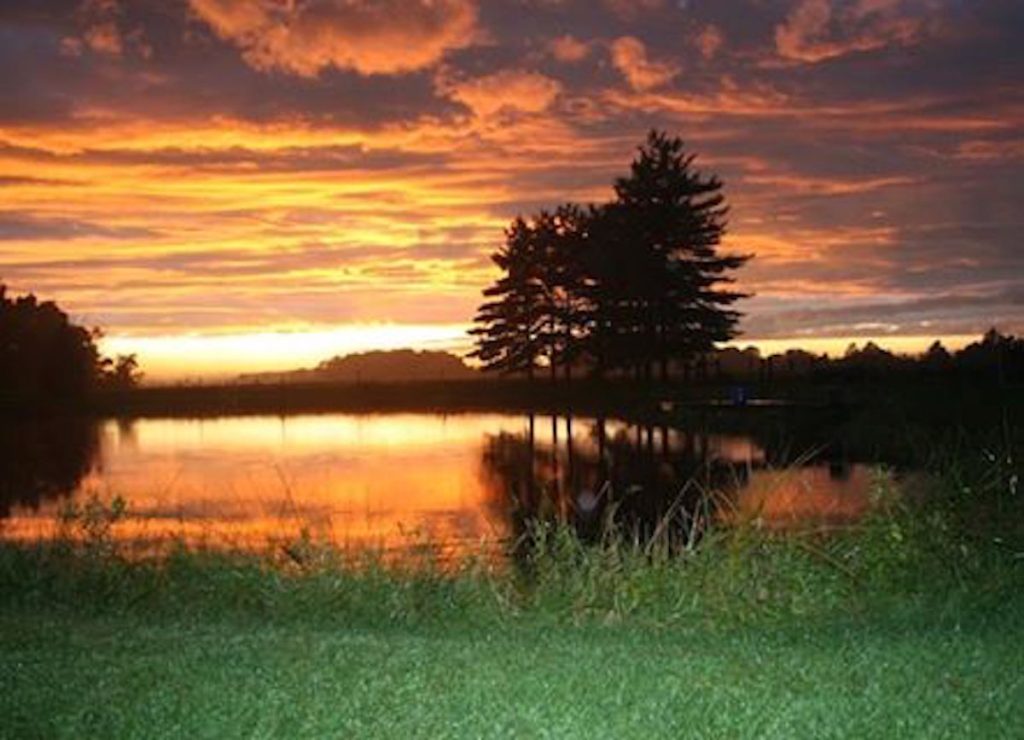
Sunset on the farm photo by Nathan
Retirement from full time work often opens up many artistic doors explain how this has influenced your life?
I honestly don’t think of myself as retired. I went to university and received an art degree and proceeded to teach children art for 28 years. Now, in instead of going to teach children, I go into my studio daily and go to work on my own projects. I now have more personal studio time for exhibitions work as well as teaching adults.
Discuss how important form is in your work?
I believe that my earlier studies in ceramics have had a great influence on my felt forms. I like my work to be precise, well crafted and almost give you the feeling of a ceramic form. I take a great deal of time thinking about the final form and how I will get to that form using a flat pattern. I spend hours shaping, correcting balance and cleanliness of line and form.
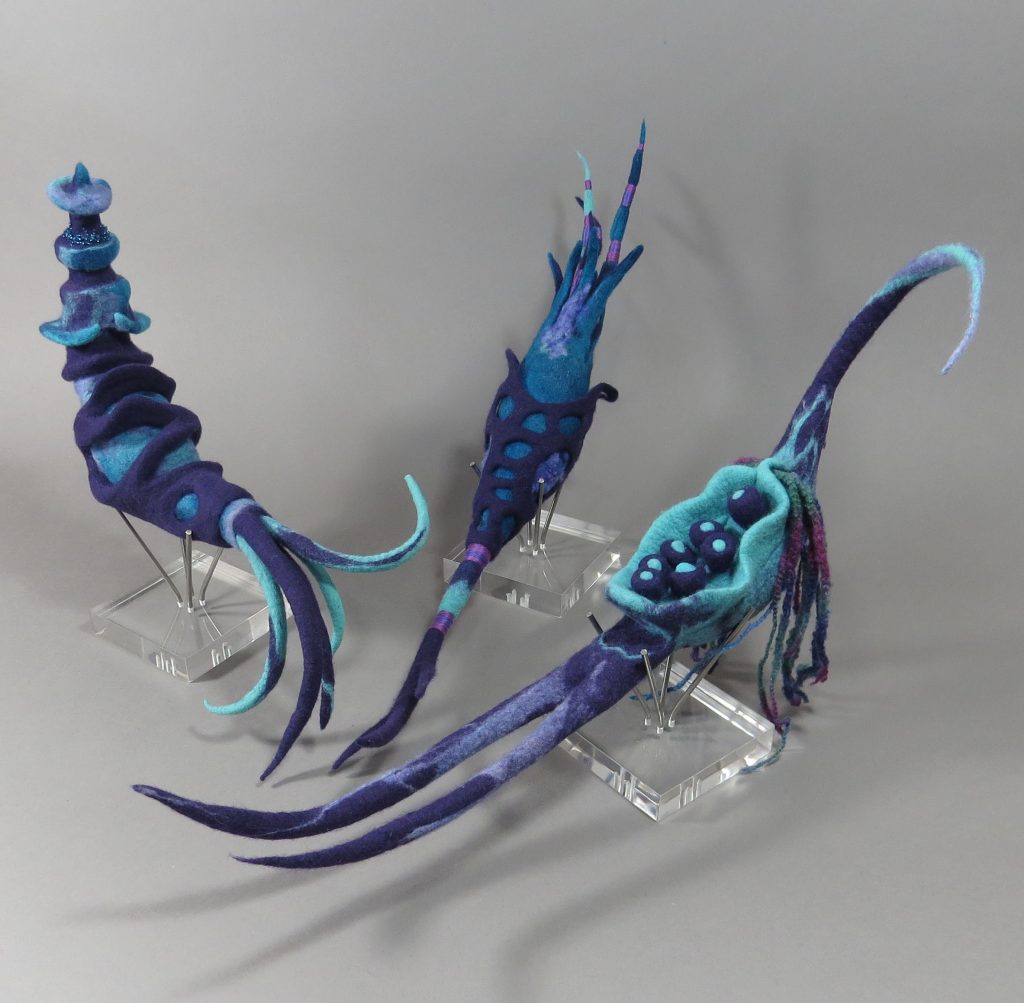
Why teapots; especially in felt?
Oddly enough, I have had my own teapot collection for years but it never even entered my mind to make one in felt. I was making felt vessels with well-fitted stoppers for several years and Amy Morgan, owner of The Morgan Contemporary Glass Gallery sent me an invitation to join her annual teapot show. Since that showing I have been totally enamoured with felt teapots. Who would have guessed teapots made out of wool would be loved worldwide. Each one is different and each one is a new challenge to me.
Can you take 2 teapots and discuss.
The inspiration, form and design
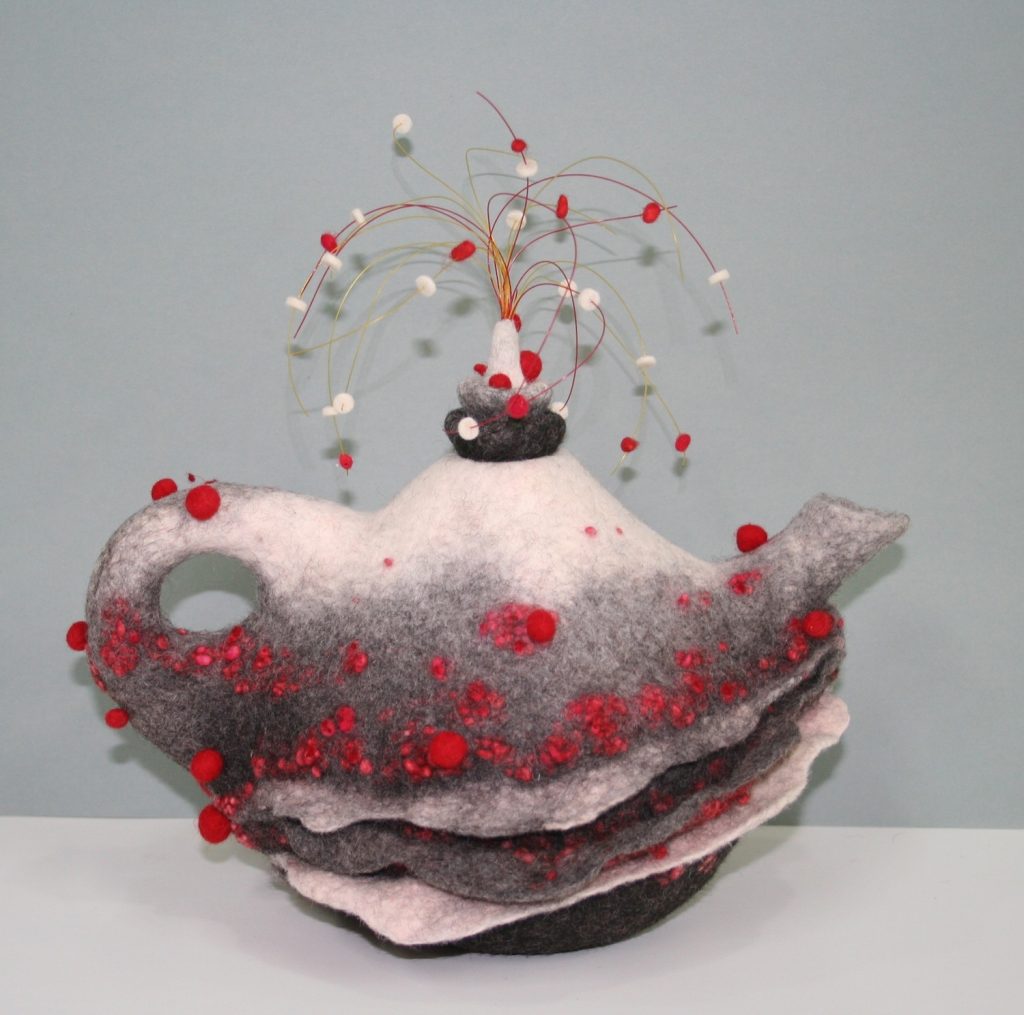
The first teapot is called Carnival. It is made out of natural colored Finnish wool. I used red merino accents and hand dyed monofilament for an explosion coming out of the stopper. I cannot remember the inspiration and I am not sure I even made a sketch for this one. It just flew out of my head and my hands went to work.
I take pride in getting my stoppers to fit tightly like wine corks. When the body of the teapot is finished I design the stopper. Each stopper is like a mini vessel and must fit the character of the teapot.
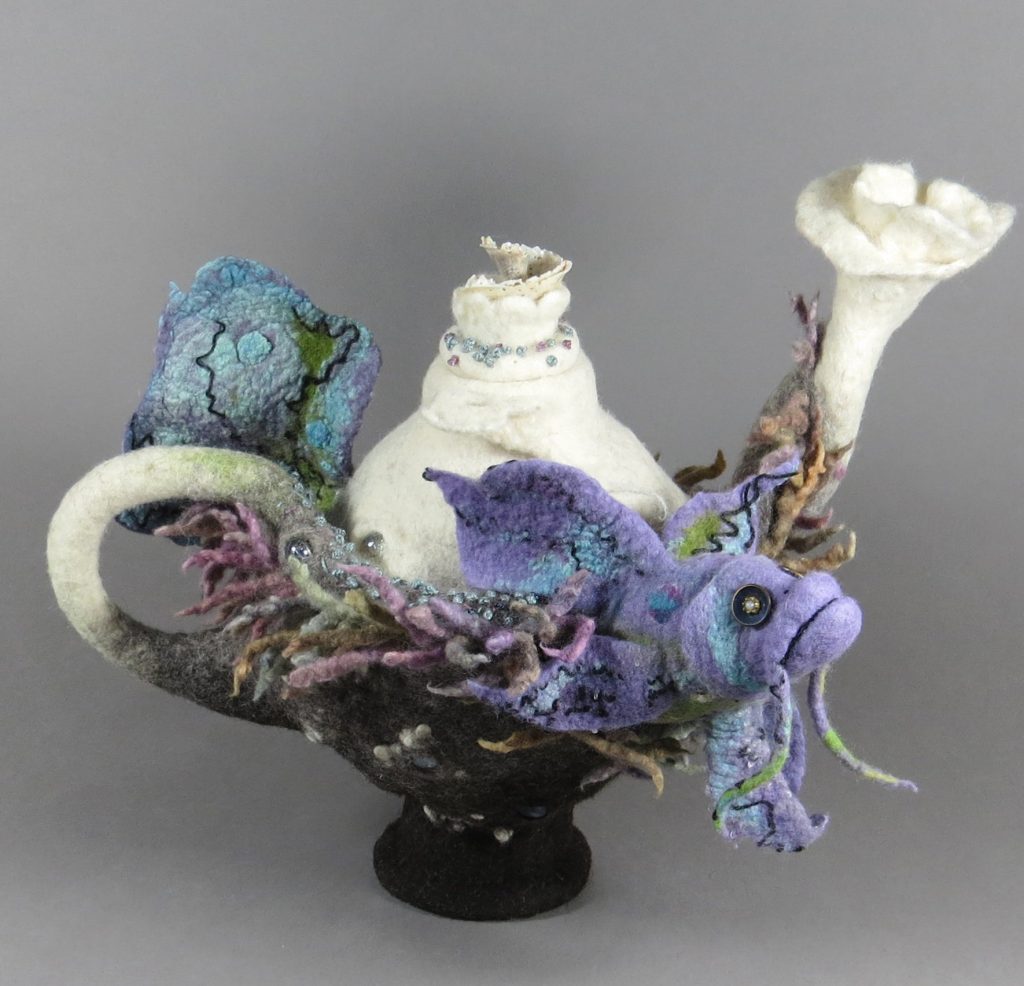
The second teapot is one of the newest teapots and on display at The Morgan Contemporary Glass Gallery 9th annual Teapot Show in Pittsburgh Pennsylvania, USA. It is titled On the Reef. I was inspired by the beautiful fish and reefs in Hawaii.
This teapot was made using multiple resists taped onto the main resist. The wool is Finnish wool with merino. I use merino and silk for the fish and added interesting texture with yarns, embroidery, glass beads, larger glass pebbles, antique button eyes and a shell in the stopper. The base is quite narrow and I had quite a time balancing the rest of the teapot. It was very top heavy but the handle and spout designs pulled it together. It stands very nicely now.
Discuss an aspect that was initially a new learning part within the work.
In each teapot or sculpture I begin, I always try to make it unique and add new techniques. This is the fun part for me. I never really know it will come out but I go with the flow and let the wool and work take me on its special journey. I firmly think there are no rights or wrong and no rules to be followed. You have to give up at some time during the making and be content with where the wool takes you.

Balearica Tea Pot
Can you discuss how you keep the form solid?
I use a flat resist to begin my felt teapot. When the wool has felted enough to remove the resist it is carefully removed and I begin to shape the hollow form into a 3 dimensional teapot. If my teapots were ceramic, they would be totally functional. Occasionally I will stiffen the inside with an acrylic liquid. I will do this only in the areas that might get damaged in shipment.
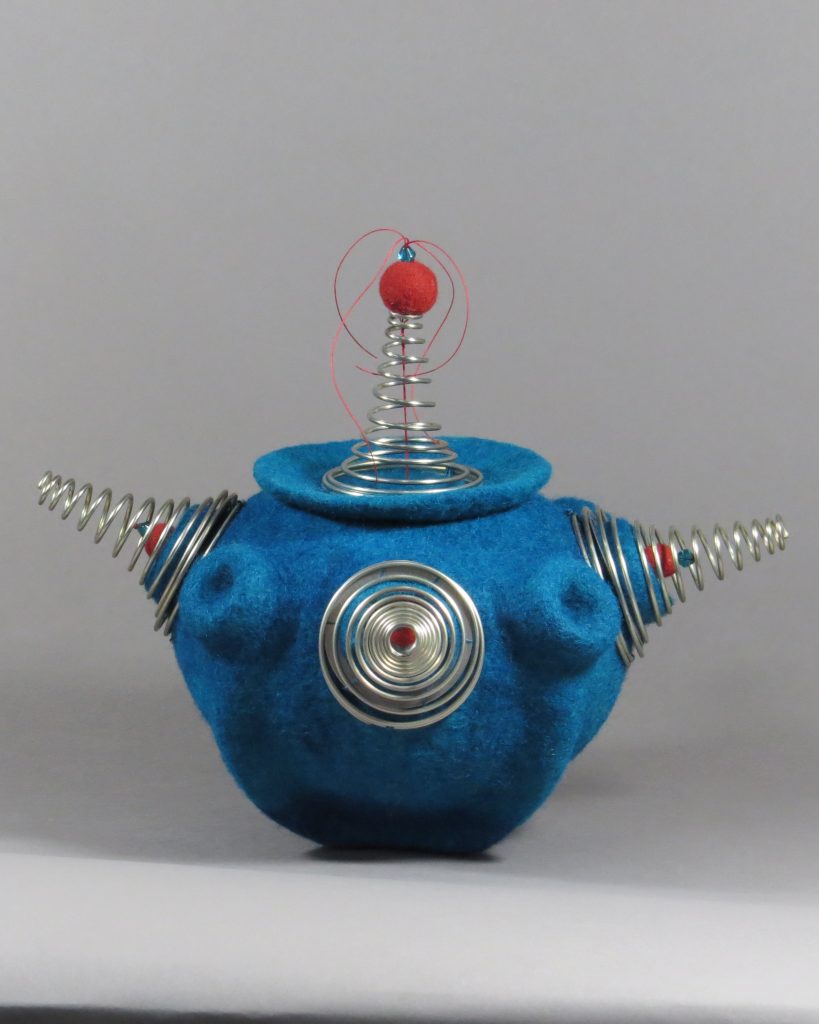
When did you decide to specialize in sculptural felt?
My first felt making workshop was actually in hat making. It seemed to me that a hat is simply a vessel turned upside down. I got more excited thinking about the challenges in making stoppers, handles, and spouts then in hat making.
How important is it to be able to work with natural materials?
I will repeat what I tell my students. There are no rules. It is all-good. Whatever works for you, do it! I like to mix it up and use found objects; man made materials, whatever seems right at the time for a specific work. My goal is not to be a felt purest, but to be an artist that happens to use felt in her work along with whatever else fits in.
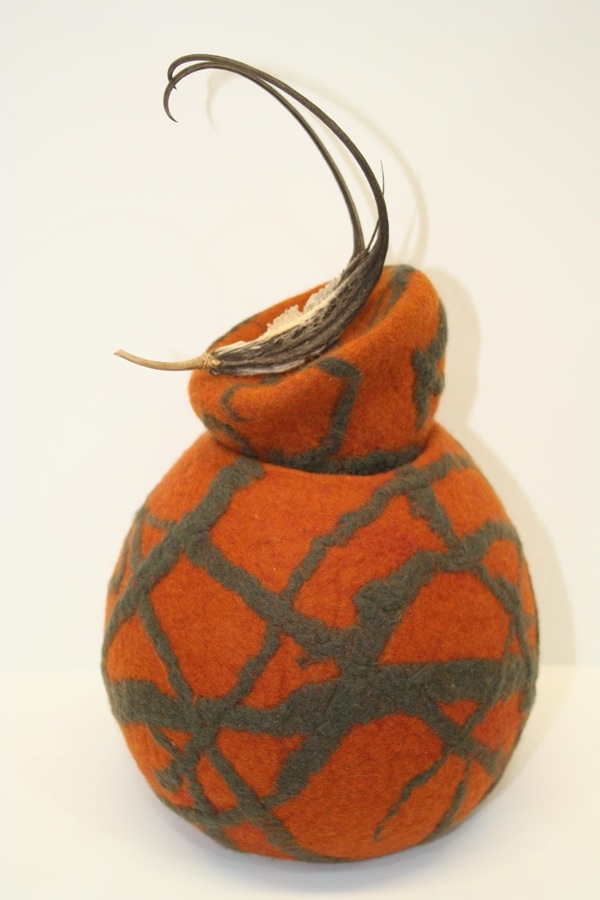
Devil’s Claw
Monochrome colour is very important in your work, discuss?
In my newer work I am finding I am most comfortable with the natural colours of the wool using just a pop of colour. On the Reef was a jump out of my comfort zone with its use of colour and busy texture. Most of my work has been very monochromatic using gentle gradation.
You also do 2D work, discuss one in particular, “Self Portrait”?
My self-portrait with chicken inspiration came from my fiber group, Fiber Forum. It is a group of 12 amazing fibre artists. We all decided to make a self-portrait in our medium of choice. I am a felter and a farm gal. I loved my flock of chickens and it seemed natural to combine the two subjects into a self portrait. It is both needle felt and wet felted along with beads and stitching on denium. My interest in 2-D is on the rise and I see more wet felted wall art coming.
Your felt workshops have taken you around the world expand on both the workshops and the travel they have given you?
I love teaching and travel but would not be able to do any of this without the help from my husband. He graciously takes over my farm chores while I am gone.
In 2014 I had the privilege to teach 18 workshops with in a 9-month period in the USA, Australia, Ireland, and England. I feel traveling by myself has empowered me as a woman and given me experiences that are far beyond what I had ever imagined I’d experience at age 65. I have lost the fear of “What if I get lost?” This same fear of getting lost has also merged into my artwork and I have learned to just go with the flow and enjoy the ride.
Discuss your thoughts on the current contemporary Felt Associations and how they are working to promote the art of Felting?
How and where do you see Felting is going in the future?
I love the new contemporary work being created all over the world. Felters are a relatively small group of makers but so global and willing to share. The interest in workshops and the growth in felt making is enormous. I think the newest trend is towards wall hangings and more and more mixed media. I see wonderful growth for felt artist and makers.
pammacg@roadrunner.com
www.tarveycottagestudio.com
Interview by Deborah Blakeley, June, 2015
Think a colleague or friend could benefit from this interview?
Knowledge is one of the biggest assets in any business. So why not forward this on to your friends and colleagues so they too can start taking advantage of the insightful information the artist has given?
Other artists you may be interested in:

